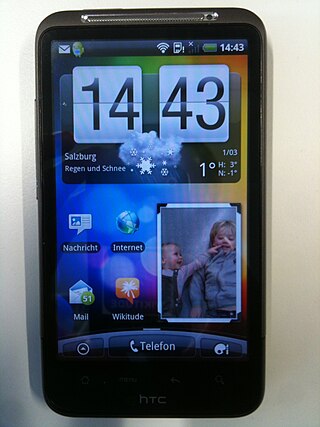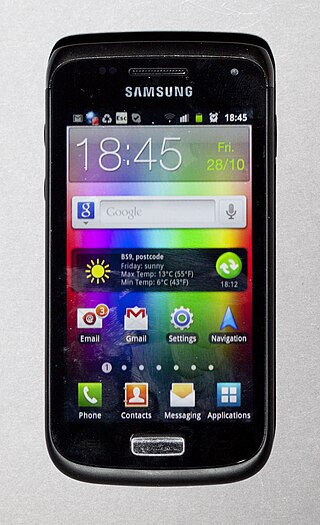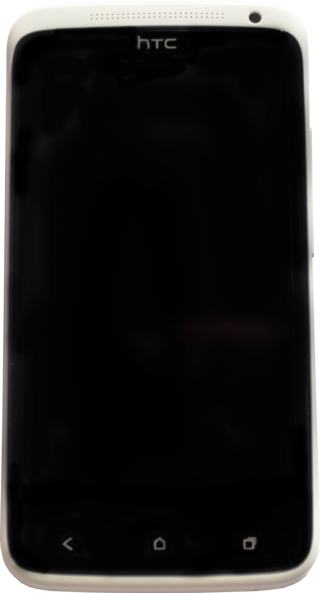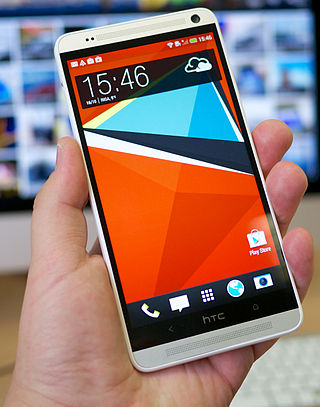Related Research Articles

HTC Sense is a software suite developed by HTC, used primarily on the company's Android-based devices. Serving as a successor to HTC's TouchFLO 3D software for Windows Mobile, Sense modifies many aspects of the Android user experience, incorporating additional features, additional widgets, re-designed applications, and additional HTC-developed applications. The first device with Sense, the HTC Hero, was released in 2009. The HD2 running Windows Mobile 6.5, released later the same year, included Sense. Following the release of the Hero, all future Android devices by HTC were shipped with Sense, except for the Nexus One, the Desire Z, the HTC First, the Google Pixel and Pixel 2, and the Nexus 9 which used a stock version of Android. Also some HTC smartphones that are using MediaTek processors come without HTC Sense.

The HTC Desire is the first smartphone of the Desire series developed by HTC. It was announced on 16 February 2010 and released in Europe and Australia in the second quarter of the same year. The HTC Desire was HTC's third flagship phone running Android 2.1 Eclair which can be upgraded to 2.2 Froyo or 2.3 Gingerbread. Internally it bears a strong resemblance to the Nexus One, but differs in some features.

The HTC Desire HD is an Android smartphone by HTC Corporation. It was unveiled at a press event in London hosted by HTC on September 15, 2010, and was made available for sale in October in Europe and in January 2011 in Canada. The Desire was HTC's fourth flagship Android device until the release of their new line of flagship model, the HTC Sensation.

The HTC Sensation is a smartphone designed and manufactured by HTC Corporation that runs the Android 2.3 Gingerbread software stock. Officially announced by HTC on April 12, 2011, the HTC Sensation was launched by Vodafone in key European markets including the United Kingdom on May 19, 2011 and by T-Mobile in the United States on June 12, 2011. It was HTC's fifth flagship Android phone and the first HTC phone to support the HTC Sense 3.0 user interface. At the time of its release, the Sensation XE was the world's fastest Android phone.

Samsung Galaxy W (i8150), also known as Samsung Wonder, is an Android smartphone that is a smaller-sized variant of Samsung Galaxy S II.

The HTC One X is a touchscreen-based, slate-sized smartphone designed and manufactured by HTC. It was released running Android 4.0.3, with the HTC Sense 4.0 skin. The One X is powered by the NVIDIA Tegra 3 for most international GSM carriers, making this the first HTC phone to be equipped with a quad-core processor, while a variant which is LTE capable is powered by the Qualcomm Snapdragon S4 dual-core 1.5 GHz Krait processor. The One X was announced on February 26, 2012, at the Mobile World Congress and was HTC's sixth flagship product, leading the HTC One series from the time of its release through April 2013, when its successor the HTC One (M7) was announced.
The HTC Rhyme is a multi-touch, slate-format Android 2.3 smartphone designed and produced by HTC. The Rhyme was released in the United States exclusively by Verizon Wireless on September 22, 2011, with releases in Asia and Europe beginning in October 2011. The Rhyme is a mid-range smartphone, distinguished by its use of an updated HTC Sense 3.5 user experience, and a selection of bundled accessories; such as a charging dock, wireless speakers, and an LED "charm" that can be used as a notification light. While it was not explicitly marketed as such by HTC, the Rhyme was primarily developed and targeted towards women.
The HTC First is an Android smartphone released by HTC on April 12, 2013. It was unveiled on April 4, 2013, as part of a press event held by Facebook. Serving as a successor to a pair of Facebook-oriented devices HTC released in 2011, it was the first and only Android device to be pre-loaded with Facebook's own user interface layer, Facebook Home, in lieu of HTC's own Sense.

The HTC One Max is an Android phablet smartphone designed and manufactured by HTC. The device is a larger variant of HTC's 2013 flagship high-end smartphone, the HTC One, notably incorporating a 5.9-inch display and fingerprint recognition features.
The HTC Desire 601 is an Android smartphone designed and manufactured by HTC. The Desire 601 is a mid-range device carrying design traits from the HTC One and One Mini, utilizing a dual-core processor, 4.5-inch qHD display, and offering LTE support.

The HTC One (M8) is an Android or Windows smartphone manufactured and marketed by HTC. Following a number of leaks that occurred during the months prior, the device was officially unveiled in a press conference on March 25, 2014, and released the same day by Verizon Wireless at retail, and by other Canadian and United States carriers for online orders prior to its wider retail availability in mid-April.

The HTC Desire 610 is an Android-based smartphone designed and manufactured by HTC. It is an affordable smartphone part of the Desire range of mid-range handsets, and was aimed at the same market sector with devices such as the Motorola Moto G, Sony Xperia M2 and Nokia Lumia 735. It was announced on 24 February 2014 at Mobile World Congress 2014 in Barcelona, Spain. It was released in China in March 2014, in Europe starting April 2014 and in Australia on 5 August 2014.
The HTC One (E8) is a high-end Android smartphone released by HTC in 2014. It has been described as a cheaper version of the HTC One (M8), and the two devices share many similar features.

The HTC Desire Eye is an Android smartphone manufactured by HTC. The phone was announced on 8 October 2014 and was released on 7 November 2014 exclusively for AT&T in the United States and exclusively for Three in the United Kingdom. It is known as the selfie phone because the front camera has the same quality of imaging as the rear camera.

The Huawei Ascend P7 is a high-end smartphone by Huawei running the Android operating system. It was announced in May 2014 and released in June 2014. It received mixed to positive reviews, with most critics noting the slim glass construction, good front camera quality, and slow processor.

The HTC Desire 200 is a low-end Android smartphone released by HTC in 2013. It uses a 3.5-inch display and single-core 1 GHz processor. It was officially unveiled on 18 June 2013 on the website of HTC. Its Taiwan release price was NT$4990.
The HTC Desire 520 is a low-end Android smartphone released by HTC in 2015. The phone received mixed reviews. CNET described the phone as "[a] cheap Android device that sacrifices too much". Gadget Guy noted the phone's long battery life, but also described the phone as "one of the slowest phones [they have] ever reviewed" and its screen quality as sub-par.
The HTC Desire 616 is a mid-range Android smartphone released by HTC in 2014. It is the first HTC smartphone with an octa-core processor. It was launched on 7 July 2014 in Asian markets. On 11 July 2014, the phone was launched in India for 16900 INR.

The Nokia 3 is a Nokia-branded entry-level Android smartphone designed and marketed by HMD Global. It was announced on 26 February 2017, a day before the Mobile World Congress started, along with the Nokia 6, Nokia 5, and Nokia 3310 (2017). The phone receives regular monthly security updates and runs stock Android. Nokia 3.1 and others released after Nokia 3.
References
- ↑ Kim, Eugene (October 27, 2014). "HTC Desire 510 (Sprint)". PCMag. Archived from the original on 2019-04-16. Retrieved 2019-04-16.
- ↑ Hanson, Matt (October 23, 2014). "HTC Desire 510 review". TechRadar. Archived from the original on 2019-04-16. Retrieved 2019-04-16.
- ↑ Hoyle, Andrew (November 28, 2014). "HTC Desire 510 review". CNET. Archived from the original on 2019-04-16. Retrieved 2019-04-16.